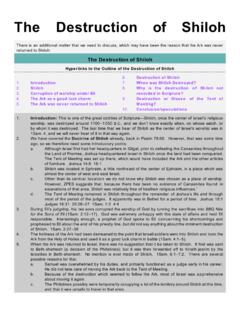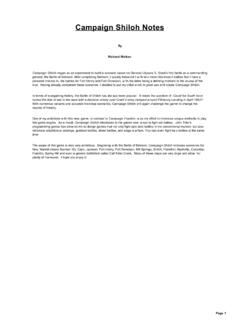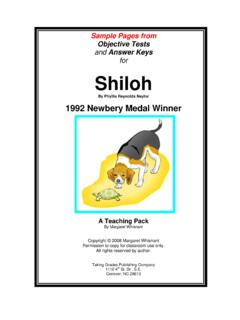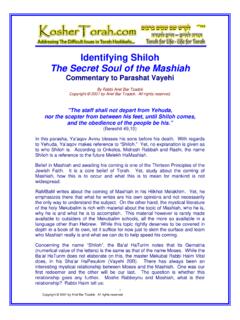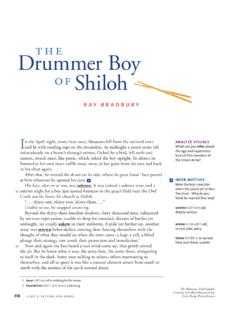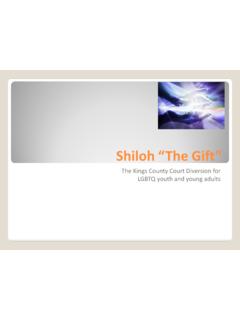Transcription of PERFORMANCE SHILOH II TECH SHEET BREEDER DESCRIPTION
1 Association with legumes then select those maturity classes that will match most closely with the associated legume or companion crop. PERFORMANCES hiloh II has been tested extensively in North America. Recent tests in Kentucky and Illinois show SHILOH II as one of the highest forage producers among new and improved orchardgrass varieties. Catch a rising star and sow SHILOH II in your next forage seeding project. SEEDINGD ates: Spring and fall when soil temperatures are above 60 F or higher. Orchardgrass is generally intermediate to slow in tillering. Therefore, higher soil temperatures and an increasing photoperiod in spring or warm soils with a decreasing photoperiod is the fall provide optimal environment for seedling emergence.
2 Soil preparation: Prepare a firm seed bed free of clods, sticks and vegetative debris. Seed should be in contact with the soil. Rolling the soil following harrowing to aid in retaining soil SHILOH II TECH SHEETVARIETYSHILOH IIPotomacOlympiaTuckerAmbrosiaLSD @ Yield% of SHILOH II100%96%95%84%78%2006 Cool Season Grass Variety TrialUrbana, IL (Yield tons per Acre DM)Established April 2006 BREEDERR adix Research, II is an early flowering, winter hardy, long-lived perennial bunchgrass with exceptional forage quality. It provides better full season dry matter yields than Potomac. SHILOH II exhibits an erect, open bunch type sod making it more compatible with adapted legumes such as alfalfa, red clover, birdsfoot trefoil and ladino clover.
3 SHILOH II also exhibits early spring green-up, good winter active growth and a disease free forage II is recommended for intensive rotational grazing, pasture, hay, green chop and silage but requires better management than tall fescue for higher yields and forage quality. Close continuous grazing will weaken stands and is best utilized on neutral pH soils with good internal and surface drainage. MATURITYO rchardgrass typically matures earlier in the spring than legume companion crops. This results in decreased protein and digestibility of the orchardgrass when the legume companion crop is at its highest stage of forage quality.
4 Therefore, orchardgrass varieties are classified based upon relative maturity to assist in forage quality management decisions. Three classifications of maturity are recognized, early, intermediate and late. If orchardgrass is to be grown Growth HabitEstab. Rate daysAnerobic Soil RangeMin. Rainfall InchSeeding Rate lb/aDry MatterN. ReqRe-growthPrimary UtilizationVeg. Reprod. Tiller RateEndophyteCP%2 NDF2 ADF2 TDN2 Perennial >1815-20 2-5 Med- High 100-200 lbs/acreFair to good1-Hay 2-Pasture 3-Rotational should be considered. Rate: Drill 15-20 pounds per acre. Seeded with legumes consider: 3-5 pounds of SHILOH II and 12-15 pounds of alfalfa, red clover, white clover or birdsfoot trefoil per acre.
5 Soils must be well drained with good fertility for optimal forage production. Depth: Drill sow - inch. CULTURAL PRACTICESpH: Soil pH is best in range of Orchardgrass is more tolerant of alkaline than highly acidic soils. NPK requirements: Orchardgrass is very responsive to nitrogen fertility and requires more than other cool season forage grasses. A split application in spring and fall of 50-150 lbs nitrogen per acre annually is recommended. Apply 1/3 in fall and the other 2/3 in late winter to mid-spring. The fertility requirement for phosphorous and potassium is moderate to high respectively. If P and K are limiting, then other cool season grasses such as tall fescue and Kentucky bluegrass can dominate.
6 In mixtures with legumes, the absence of available P and K will significantly contribute to legume decline in forage production systems. Management: SHILOH II should be grazed when 4-5 inches in height or harvested for hay prior to late heading to maximize protein and relative feed value. Delay in harvest will reduce forage quality significantly. Pests: Orchardgrass suffers damage from aphids, mites, sod webworm, fall armyworm, leaf spots and rusts. Nematodes are very serious on orchardgrasss grown in sandy soils. These pests can be controlled with standard management and cultural practices such as grazing, forage harvest and proper fertility to discourage excessive pest populations.
7 Weed Control: On sites where establishment is critical, use weed control prior to harvest or grazing by domestic animals. Many grass herbicides are generally very harmful to broadleaf species; therefore caution should be taken to avoid drift onto adjoining cropland. Post-emergent use: Banvel +2,4-D; Crossbow, Ally, Tordon, Curtail, Buctril and Prowl. Any and all reference to pesticides, herbicides and fungicides, whether generic or named products, is for general informational purposes only. Text reference is not intended as an endorsement, nor does omission imply criticism. Always read and follow label directions. Dry Matter Yields of Orchardgrass varieties planted on September 1, 2004 Princeton, KYYield ( LB DM/ACRE)*= statistically highest dry matter yieldVARIETYSHILOH IITakena IIPersistExtendHallmarkAmbassadorCommand LSD @ yr.
8 * *
